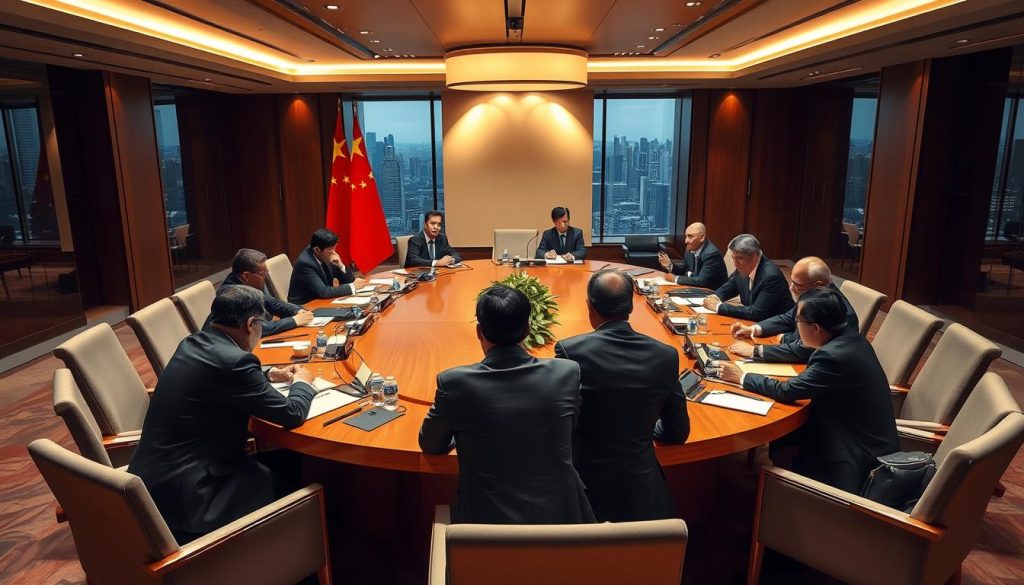China has slapped an 84% tariff on many US goods. This move is a big step up in trade fights between the two biggest economies. It hits products like chips, machines, and cars, making them pricier for US sellers.
Import tariffs are like taxes on foreign goods, making them costlier. This new move comes after years of disagreements over trade, tech, and rights to ideas.
Key Takeaways
- China’s 84% import tariffs apply to $75 billion of US goods, effective immediately.
- Import tariffs aim to protect domestic industries but can trigger retaliatory measures.
- US companies exporting machinery, electronics, and agricultural products face immediate price hikes.
- The dispute highlights deepening geopolitical rivalry over trade policies and tech dominance.
- Global markets are watching for further actions as tensions risk slowing worldwide economic growth.
Understanding the Impact of Tariffs on US Trade
Tariffs are more than just numbers. They change how countries trade with each other. For the US, these taxes can alter market trends and affect global partnerships. Let’s see how they impact economies and industries.
The Role of Tariffs in Global Economics
Tariffs are economic tools. Countries use them to protect their industries and balance trade. For the US, they can make businesses look for local materials or new partners. But, when tariffs go up, trade changes, affecting everything from car parts to tech.
Global supply chains then adjust, bringing both challenges and chances for businesses everywhere.
Implications for American Industries
American companies feel the impact. Let’s look at some key areas:
- Manufacturing: Higher costs for steel and machinery imports
- Technology: Supply chain delays for electronics
- Consumer Goods: Price hikes on everyday items
Economists warn that prolonged tariff disputes can disrupt supply chains and raise consumer costs.
These changes in US Trade policies force businesses to adapt. Companies might change where they make goods or how they price them. These decisions affect the whole economy, from factories to grocery stores.
Diplomatic Dynamics Behind the Trade War
Behind the scenes of tariff battles, a complex web of diplomatic strategies exists. Nations weigh their economic goals against their geopolitical ambitions. This shapes the trade conflict’s path. We’ll look into the hidden negotiations and choices that drive both sides’ actions.

China’s Strategic Response
China’s 84% tariff decision is a calculated move in Global Economics. Officials aim to protect domestic industries while showing resolve in trade talks. Beijing wants to avoid making long-term concessions and strengthen its role in global supply chains.
Diplomatic cables highlight the importance of protecting key sectors like technology and manufacturing.
US Policy Shifts and Reactions
Washington is adjusting its alliances in response. The US is looking to form partnerships with the EU and Asian nations to counter China’s influence. Recent actions include:
- Renegotiating trade deals to enforce fair practices
- Boosting domestic manufacturing incentives
- Amplifying pressure on tech exports to China
These steps show a move towards multilateral strategies. The goal is to realign Global Economics power structures. Officials aim to maintain competitive advantages without cutting ties completely.
Economic Repercussions and Global Market Shifts

The Trade War Impact has changed global markets. Companies now think differently about their supply chains. For example, Ford and Apple face higher costs because of tariffs.
Factories in Southeast Asia are seeing more business. This is because companies are moving there to avoid U.S.-China border taxes.
- Automotive sector: 15% price hikes on imported vehicles
- Tech firms: Component delays due to shipping bottlenecks
- Manufacturers: 200+ companies shifted production bases in 2023
| Sector | Trade War Impact |
|---|---|
| Electronics | Component shortages |
| Textiles | Raw material price spikes |
| Agriculture | Wheat exports redirected to Brazil |
Investors are trying to protect their money by spreading it across different areas. A report by S&P Global says $450 billion in supply chain shifts have happened since 2018. Retailers like Walmart are now getting 30% of their toys from Vietnam, not China.
Markets are still shaky. Companies are trying to save money while also dealing with political risks. The next steps in this trade war could make some industries do well, while others struggle.
Conclusion
Trade disputes between China and the U.S. show how tricky it is to balance economic policies and global cooperation. Tariffs make imports more expensive, affecting businesses and consumers. It’s crucial to keep talking to ease tensions and understand each other better.
Both countries need to focus on dialogue to avoid harming supply chains and market stability. This is key to preventing long-term damage.
Economic effects of these disputes spread far, touching industries from making goods to selling them. While making quick fixes is needed, lasting solutions require common goals. Experts say policymakers should think about the bigger picture, making sure trade policies don’t block innovation or global growth.
The way forward needs flexibility, with both sides looking at new strategies. They must align economic goals with diplomatic ones.
Global markets are watching as these issues play out. Finding a solution means balancing protectionism with teamwork. By tackling main concerns openly, leaders can turn problems into chances for stronger economic ties. The outcome will influence not just the U.S. and China but also the future of global trade.










